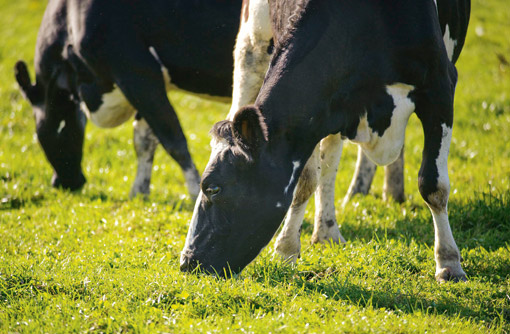Boosting milk yield from grass

One Cheshire farmer is looking to increase milk income by about £11,000 by careful management of grass. Jeremy Hunt reports,
A strong focus on grass variety is allowing Cheshire farm manager Phil Asbury to produce as much milk as possible from grazed grass rather than relying too much on conserved forage.
Despite difficult spring conditions, the 210 milkers at Clive Hall, Winsford, were turned out in February on to a “wedge” of grass that had been built up on pastures during late autumn.
The cows stayed out all February and March, but were housed at night during April as the ravages of the late winter took their toll on paddock recovery rates.
With such determination to exploit grazed grass for milk production, Mr Asbury has a clear target of expectation when it comes to the amount of dry matter he expects his leys to produce.
“We need 12 tonnes of dry matter for every hectare of used grass, and to achieve that level we have to grow 14 tonnes of dry matter a hectare to take account of the fact only 85% of what we grow is actually grazed. To meet that target the varieties of grass we need to put in front of the cows have to be very palatable and produce plenty of leaf.”
Mr Asbury says they are taking a very close look at everything that influences grazed grass – P and K profiles, pH and drainage and improving any compaction with sub-soiling.
Back to basics
“In other words, we’re getting back to basics in the way we manage our soil, so that it’s in the best condition to support the grass we’re asking it to grow.
“If we get that right – and grow the right grass varieties – we should be able to graze grass down to between 4cm and 5cm at each grazing round. We want to get away from covering up poor leys by just propping them up with more fertiliser,” says Mr Asbury.
The grazing at Clive Hall, which is a Monitor Farm with the Livestock Northwest programme, was ready to undergo changes, but an initial experience with a grass variety that is said to help extend the grazing season, wasn’t successful. Mr Asbury studied at first hand the trial work under way at the Teagasc Dairy Research Centre in Northern Ireland involving tetraploid ryegrasses. He was impressed with their performance and believes these varieties will most effectively meet the grazing criteria at Clive Hall.
Research
“The work at Teagasc compared tetraploids with diploids, based on the condition of the sward pre-grazing. While diploid varieties were marginally superior in terms of kilos of dry matter a hectare and sward density, the tetraploids edged ahead on digestibility (g/kg of DM) and leaf production (g/kg DM) – and these were the two we were most interested in as the characteristics we wanted in our paddocks.”
Further investigations at Teagasc, comparing tetraploids and diploids in relation to milk production, produced some interesting results.
Cows grazing tetraploid grasses from spring to late summer over a two-year period gave more than one litre a day more than those grazing diploids. While butterfats were identical, there was an overall higher Total Milk Solids figure for the tetraploid milkers.
“The research has shown that intakes of the tetraploids were higher and these grasses had more leaf growth, creating a higher digestibility,” says Mr Asbury.
Boost from tetraploid
The farm re-seeds about 10% of its grassland every spring. The switch to using tetraploids is expected to produce about one litre of extra milk production a cow.
“We reckon we could be producing an extra £60 worth of milk from our 210 cows, with the potential to increase milk income by about £11,000 a year.”
“We’re trying to grow as much grass to graze as possible, but if we’ve got paddocks producing eight or nine tonnes of dry matter that should be giving us 12 tonnes we know they are underperforming.
“This farm can grow 14 tonnes of dry matter a hectare and the target is to produce that and to get 12 tonnes actually eaten. But to achieve that output and get 85% utilisation of grazed grass from these leys, we need to look to grass varieties that can do it without having to rely so much on nitrogen” says Mr Asbury.
Re-seeding
RADA grassland consultant Dr George Fisher, based at Reaseheath College in Cheshire, says dairy farmers planning to re-seed this season should use the opportunity to improve soil conditions and to factor persistency into their choice of grass varieties.
“There aren’t any magic solutions to growing grasses that will cope with the difficult growing seasons we’re experiencing, but farmers intending to re-seed can do a lot to improve the way their new swards will cope. Getting a spade to check for compaction is essential. If there’s a problem now’s the time to deal with it and get the plough in.
“It’s important to study grass variety lists very carefully and take account of persistency rates as well as digestibility and yield. This is a good time to consider persistency more than may have been necessary in the past, but all varieties have had very difficult conditions to cope with over the past two years.
“Cover your basics with tetraploids and diploids and tip the balance towards tetraploids for maximum grazing intakes,” says Mr Fisher.
This year’s Livestock Event had a dedicated forage area. Get all the news from the event to find out more
